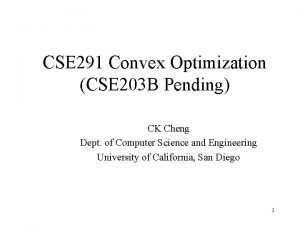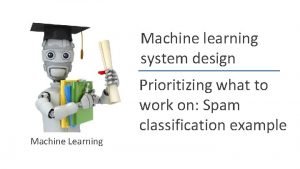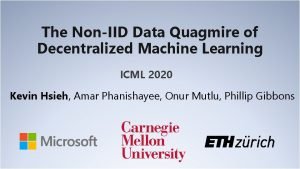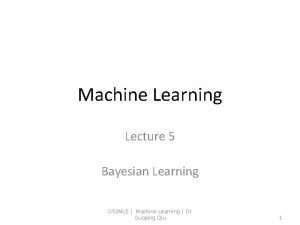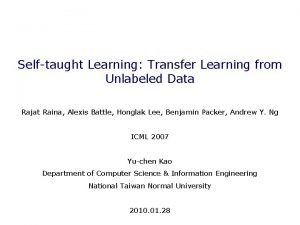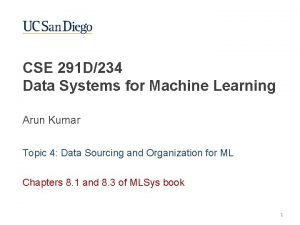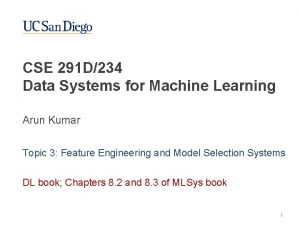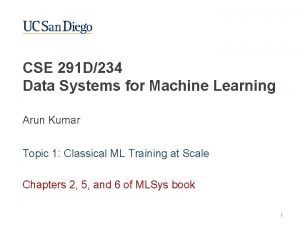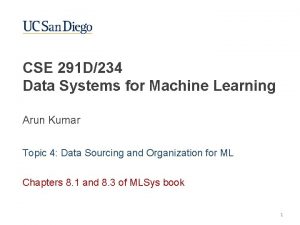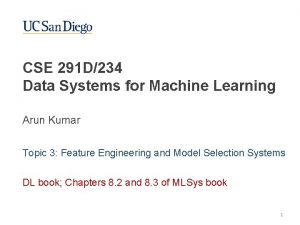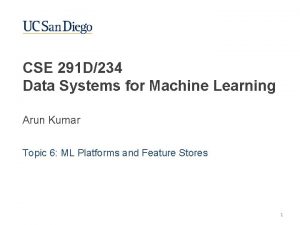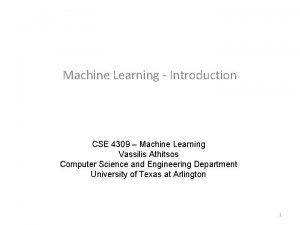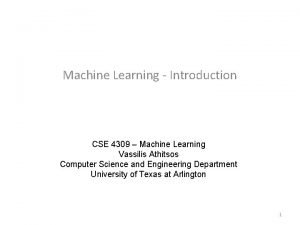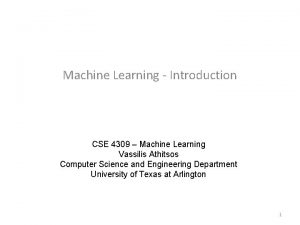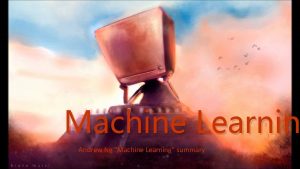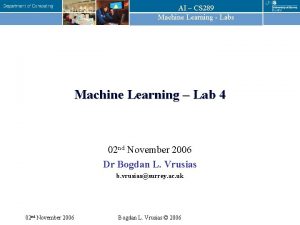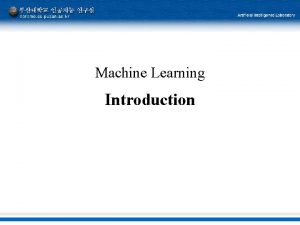CSE 291 D234 Data Systems for Machine Learning








































- Slides: 40

CSE 291 D/234 Data Systems for Machine Learning Arun Kumar Topic 5: ML Deployment Chapter 8. 5 of MLSys book 1

ML Deployment in the Lifecycle Data acquisition Data preparation Feature Engineering Training & Inference Model Selection Serving Monitoring 2

ML Deployment in the Lifecycle 3

Outline ❖Offline ML Deployment ❖Online Prediction Serving ❖ML Monitoring and Versioning ❖Federated ML 4

Offline ML Deployment ❖ Historically, “offline” was the most common scenario ❖ Still is among most enterprises, sciences, healthcare ❖ Typically once a quarter / month / week / day ❖ Aka “model scoring” ❖ Given: A trained ML prediction function f; a set of (unlabeled) data examples ❖ Goal: Apply f to all examples efficiently ❖ Key metrics: Throughput, cost, latency 5

Offline ML Deployment: Systems ❖ Not particularly challenging in most applications ❖ Typically all ML systems support it by default In-memory: Disk-based files: Cloud-native: Decision tree-oriented: Layered on RDBMS/Spark: “Auto. ML” platforms: Deep learning-oriented: 6

Offline ML Deployment: Optimizations Q: What systems-level optimizations are possible here? ❖ Parallelism: ❖ Inference is embarrassingly parallel across examples ❖ Factorized ML (e. g. , in Morpheus): ❖ Push ML computations down through joins ❖ Pre-computes some FLOPS and reuses across examples Example: GLM inference: 7

Offline ML Deployment: Optimizations Q: What systems-level optimizations are possible here? ❖ More general pre-computation / caching / batching: ❖ Factorized ML is a specific form of sharing/caching ❖ Other forms of “multi-query optimization” possible Example: Bulk inference for separate GLMs: Reduces memory stalls for X; raises hardware efficiency 8

Hummingbird: Classical ML on DL Tools ❖ An optimizing compiler to convert classical ML inference computations, especially tree-based methods, to tensor ops to exploit DL runtimes, GPU/TPU, etc. ❖ Branch-heavy instructions -> dense tensor arithmetic 9

Hummingbird: Classical ML on DL Tools ❖ Interestingly, it pays off to embed “useless” calculations in tensor (beyond what is exactly needed for tree) due to massive parallelism of tensor backends! ❖ Slower on 1 or few examples; faster on larger batches ❖ 2 x-3 x faster than SKLearn/ONNX on CPU; 10 x on GPU 10

Outline ❖Offline ML Deployment ❖Online Prediction Serving ❖ML Monitoring and Versioning ❖Federated ML 11

Online Prediction Serving ❖ Very common among Web companies ❖ Usually need to be realtime; < 100 s of milliseconds! ❖ Aka “model serving” ❖ Given: A trained ML prediction function f; a stream of (unlabeled) data example(s) ❖ Goal: Apply f to all/each example efficiently ❖ Key metrics: Latency, memory footprint, cost, throughput 12

Online Prediction Serving ❖ Surprisingly challenging to do well in ML systems practice! ❖ Still an immature area; lot of R&D; many startups ❖ Key Challenges: ❖ Heterogeneity of environments: webpages, cloud-based apps, mobile apps, vehicles, Io. T, etc. ❖ Unpredictability of load: need to elastically upscale or downscale resources ❖ Function’s complexity: model, featurization and data prep code, output thresholds, etc. ❖ May straddle libraries, dependencies, even PLs! ❖ Hard to optimize end to end in general 13

The Rise of Serverless Infra. ❖ Prediction serving is now a “killer app” Function-as-a-service (Faa. S) aka serverless cloud infra. ❖ Extreme pay-as-you-go; can rent at millisecond level! ❖ Still, many open efficiency issues for ML deployment: ❖ Memory footprints, input access restrictions, logging / output persistence restrictions, latency 14

Online Prediction Serving: Systems ❖ A variety of ML serving systems have sprung up recently General-purpose (supports multiple ML tools): ML system-specific: TF Serving Torch. Serve 15

Clipper ❖ A pioneering general-purpose ML serving system 16

Clipper: Principles and Techniques ❖ Generality and modularity: ❖ One of the first to use containers for ML serving ❖ Supports multiple ML tools in unified layered API ❖ Efficiency: ❖ Some basic optimizations: batching to raise throughput; caching of frequently access models/vectors ❖ Multi-model deployment and flexibility: ❖ A heuristic “model selection” layer to dynamically pick among multiple deployed models; ensembling 17

Discussion on Clipper paper 18

Uber’s Py. ML https: //eng. uber. com/michelangelo-pyml/ 19

Uber’s Py. ML ❖ Older approach had coupled models with Java-based online prediction service, reducing flexibility https: //eng. uber. com/michelangelo-pyml/ 20

Tensor. Flow Serving ❖ TF Serving is a mature ML serving system, also pioneering ❖ Optimized for TF model formats; also supports batching ❖ Dynamic reloading of weights; multiple data sources ❖ TF Lite and TF. JS optimized for more niche backends/runt ime environments 21

Comparing ML Serving Systems ❖ Advantages of general-purpose vs system-specific: ❖ Tool heterogeneity is a reality for many orgs ❖ More nimble to customize accuracy post-deployment with different kinds of models/tools ❖ Flexibility to swap ML tools; no “lock-in” ❖ Advantages of ML system-specific vs general-purpose: ❖ Generality may not be needed (e. g. , Google); lower complexity of MLOps ❖ Likely more amenable to code/pipeline optimizations ❖ Likely better hardware utilization, serverless costs 22

Outline ❖Offline ML Deployment ❖Online Prediction Serving ❖ML Monitoring and Versioning ❖Federated ML 23

Background: Dev. Ops ❖ Software Development + IT Operations (Dev. Ops) is a long standing subarea of software engineering ❖ No uniform definition but loosely, the science+eng. of administering software in “production” ❖ Fuses many historically separate job roles ❖ Cloud and “Agile” s/w eng. have revolutionized Dev. Ops 24

Background: Dev. Ops https: //medium. com/swlh/how-to-become-an-devops-engineer-in-2020 -80 b 8740 d 5 a 52 25

Key Parts of Dev. Ops Stack/Practice Monitoring & Logging Building & Testing Continuous Integration (CI) & Continuous Delivery (CD) Infrastructure-as-Code (Ia. C), including Config. & Policy Version Control Microservices / Containerization & Orchestration Content Credit: Manasi Vartak, Verta. AI https: //aws. amazon. com/devops/what-is-devops/ 26

The Rise of “MLOps” ❖ MLOps = Dev. Ops for ML prediction code ❖ Much harder than for deterministic software! ❖ Things that matter beyond just ML model code: ❖ Training dataset ❖ Data prep/featurization pipelines ❖ Hyperparameters ❖ Post-inference config. thresholds? Ensembling? ❖ Software versions/config. ? ❖ Training hardware/config. ? Content Credit: Manasi Vartak, Verta. AI 27

The Rise of “MLOps” ❖ Need to extend Dev. Ops to ML semantics ❖ Monitoring & Logging: ❖ Prediction failures? Concept drift? Feature deprecation? ❖ Version Control: ❖ Anything can change: ML code + data + config. + … ! ❖ Build & Test; CI & CD: ❖ Disciplined train-val-test splits? Insidious overfitting? ❖ New space with a lot of R&D; no consensus on standards Content Credit: Manasi Vartak, Verta. AI 28

Example for ML Monitoring: TFX ❖ TFX’s “Model Analysis” lets user specify metrics, track over time automatically, alert on-call ❖ Can specify metrics for feature-based data “slices” too https: //www. tensorflow. org/tfx/guide/tfma 29

Example for ML Monitoring: Overton ❖ Envisions “code-free” ML monitoring for appl. engineers ❖ Decouples prediction appl. “task schema” and data ❖ Emphasizes monitoring of critical training subsets, specifiable using “tags” and “slices” https: //arxiv. org/pdf/1909. 05372. pdf 30

Example for ML Versioning: Verta ❖ Started with Model. DB for storing and tracking ML artifacts ❖ ML code; data; configuration; environment ❖ APIs as hooks into ML dev code; SDK and web app. /GUI ❖ Registry for versions and workflows https: //blog. verta. ai/blog/the-third-wave-of-operationalization-is-here-mlops 31

Open Research Questions in MLOps ❖ Efficient and consistent version control for ML datasets and featurization pipelines ❖ Detect concept drift in an actionable manner; prescribe fixes ❖ Automate ML prediction failure recovery ❖ Velocity and complexity of streaming ML applications ❖ Seamless CI & CD for mass-produced models without insidious overfitting ❖… 32

Outline ❖Offline ML Deployment ❖Online Prediction Serving ❖ML Monitoring and Versioning ❖Federated ML 33

Federated ML ❖ Pioneered by Google for ML appl. on smartphones ❖ Key benefit is more privacy: ❖ User’s (labeled) data does not leave their device ❖ Decentralizes ML model training/finetuning to user data https: //ai. googleblog. com/2017/04/federated-learning-collaborative. html https: //mlsys. org/Conferences/2019/doc/2019/193. pdf 34

Federated ML ❖ Key challenge: Decentralize SGD to intermittent updates ❖ They proposed a simple “federated averaging” algorithm ❖ User-partitioned updates breaks IID assumption; skews arise ❖ Turns out SGD is still pretty robust (recall async. PS); open theoretical questions still being studied https: //arxiv. org/abs/1602. 05629 35

Federated ML ❖ Privacy/security-focused improvements: ❖ New SGD variants; integration with differential privacy ❖ Cryptography to anonymize update aggregations ❖ Apart from strong user privacy, communication and energy efficiency also major concerns on battery-powered devices ❖ Systems+ML optimizations: ❖ Communicate only “high quality” model updates ❖ Compression and quantization to save upload bandwidth ❖ New federation-aware ML algorithms https: //arxiv. org/abs/1602. 05629 https: //arxiv. org/pdf/1610. 02527. pdf https: //eprint. iacr. org/2017/281. pdf 36

Federated ML ❖ Federated ML protocol has become quite sophisticated to ensure better stability/reliability, accuracy, and manageability https: //mlsys. org/Conferences/2019/doc/2019/193. pdf 37

Federated ML ❖ Google has neatly abstracted the client-side (embedded in mobile app. ) and server-side functionality with actor design https: //mlsys. org/Conferences/2019/doc/2019/193. pdf 38

Federated ML ❖ Notion of “FL Plan” and simulation-based tooling for data scientists to tailor ML for this deployment regime ❖ (Users’) Training data is out of reach! ❖ Model is updated asynchronously automatically ❖ Debugging and versioning became even more difficult https: //mlsys. org/Conferences/2019/doc/2019/193. pdf 39

Review Questions ❖ Briefly explain 2 reasons why online prediction serving is typically more challenging in practice than offline deployment. ❖ Briefly describe 2 systems optimizations performed by Clipper for prediction serving. ❖ Briefly discuss one systems-level optimization amenable to both offline ML deployment and online prediction serving. ❖ Name 3 things that must be versioned for rigorous version control in MLOps. ❖ Briefly explain 2 reasons why ML monitoring is needed. ❖ Briefly explain 2 reasons why federated ML is more challenging for data scientists to reason about. 40
 Cse 291
Cse 291 Cse 291 ucsd
Cse 291 ucsd Cse 291
Cse 291 Ceng 291
Ceng 291 Safe work method statement definition
Safe work method statement definition Designing machine learning systems
Designing machine learning systems Concept learning task in machine learning
Concept learning task in machine learning Analytical learning in machine learning
Analytical learning in machine learning Pac learning model in machine learning
Pac learning model in machine learning Machine learning t mitchell
Machine learning t mitchell Inductive and analytical learning
Inductive and analytical learning Inductive analytical approach to learning
Inductive analytical approach to learning Instance based learning in machine learning
Instance based learning in machine learning Inductive learning machine learning
Inductive learning machine learning First order rule learning in machine learning
First order rule learning in machine learning Eager learning algorithm
Eager learning algorithm Cmu machine learning
Cmu machine learning Cuadro comparativo de e-learning b-learning y m-learning
Cuadro comparativo de e-learning b-learning y m-learning The non-iid data quagmire of decentralized machine learning
The non-iid data quagmire of decentralized machine learning Machine learning and data mining
Machine learning and data mining Introduction to machine learning and data mining
Introduction to machine learning and data mining Training data in machine learning with example
Training data in machine learning with example Self-taught learning: transfer learning from unlabeled data
Self-taught learning: transfer learning from unlabeled data Formuö
Formuö Typiska novell drag
Typiska novell drag Nationell inriktning för artificiell intelligens
Nationell inriktning för artificiell intelligens Returpilarna
Returpilarna Shingelfrisyren
Shingelfrisyren En lathund för arbete med kontinuitetshantering
En lathund för arbete med kontinuitetshantering Adressändring ideell förening
Adressändring ideell förening Tidbok yrkesförare
Tidbok yrkesförare A gastrica
A gastrica Vad är densitet
Vad är densitet Datorkunskap för nybörjare
Datorkunskap för nybörjare Tack för att ni lyssnade bild
Tack för att ni lyssnade bild Att skriva debattartikel
Att skriva debattartikel Delegerande ledarskap
Delegerande ledarskap Nyckelkompetenser för livslångt lärande
Nyckelkompetenser för livslångt lärande Påbyggnader för flakfordon
Påbyggnader för flakfordon Arkimedes princip formel
Arkimedes princip formel Publik sektor
Publik sektor

